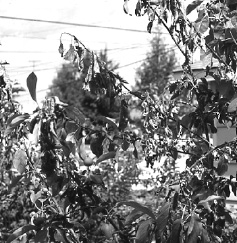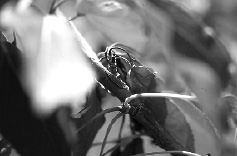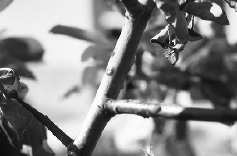| | Symptoms | Disease cycle | Cultural control recommendations | Chemical control
Fireblight, a highly destructive disease of several members of the rose family, is caused by the bacterium Erwinia amylovora. This bacterial organism is native to North America and is present throughout the continent where susceptible rose family hosts are grown.
In Alberta, this disease can affect many highly desirable hardy ornamentals and fruit-producing species in the rose family including apple, crabapple, cotoneaster, hawthorn, pear, mountain ash, raspberry, saskatoon berry, plum and cherry (Figure 1). It is particularly destructive to species that are not native to Canada such as crabapple, apple and pear.
Figure 1. Fireblight on apple and raspberry
Symptoms
Fireblight can be diagnosed by a number of distinctive symptoms. Infected blossoms suddenly become blighted and turn brown. Leaves on infected branches turn brown/black, and the twigs curl in a characteristic shepherd’s crook (Figure 2). Infected material has a scorched or burned appearance (Figure 3). In humid conditions, droplets of sticky bacterial ooze may appear on infected plant parts (Figure 4).
Leaves of infected branches may remain on the trees all summer and well into the winter. The infection progresses downward into the larger branches, killing patches of bark and forming cankers. These cankers are discolored, slightly sunken and tend to crack at their edges. If not removed, they may eventually encircle affected branches and cause all parts above the cankered areas to die.

Figure 2. Shepherd’s crook symptom of fire blight on apple
 |  |
| Figure 3. Blighted spur on apple | Figure 4. Droplets of ooze that form in high humidity conditions |
Pear and Amur cherry may display fireblight-like symptoms when infected by the bacterium Pseudomonas syringae. In such cases, a laboratory analysis may be needed to confirm the causal organism. It can be isolated onto a nutrient media and identified by growth appearance, biochemical tests and/or host-plant inoculations.
Fireblight outbreaks may occur under the following conditions
- bacteria are present on overwintered fireblight cankers or other tissues
- high relative humidity or frequent showers occur in May and June
- vigorous susceptible plant growth is present temperatures range between 18°C and 30°C
- a prolonged host flowering period occurs in combination with cool, wet spring weather
On the prairies, severe outbreaks of fireblight tend to be sporadic, occurring approximately every five or six years. Destructive fireblight outbreaks tend to coincide with wet springs and summers. Epidemic outbreaks of fireblight often follow hailstorms because injured twigs and branches provide entry points for the bacteria. Hot, dry, windy conditions tend to reduce, inhibit or prevent the build-up and spread of this disease.
Disease Cycle
Bacteria overwinter in fireblight cankers on larger branches or trunks of woody trees and shrubs as a result of infections that occurred the previous year. A large percentage of cankers die out or winterkill under Alberta conditions.
Fireblight cankers that remain viable over the winter resume activity in April and May when conditions become favourable. Bacteria in the cankers multiply, resulting in the production of a brownish liquid containing millions of bacteria that can ooze from the diseased area. Ooze formation will continue into late June. The ooze attracts flies.
Rain, wind and insects transfer the bacterial ooze from the overwintering cankers to blossoms, leaves, watersprouts and new shoots. Flies that feed on this ooze will also feed on flower nectar. One fly can carry up to 100,000 bacterial cells on its body after contact with bacterial ooze. Bees are not important in this initial spread because they normally would not visit the overwintering cankers.
Fireblight bacteria can multiply in the flowers of many species in the rose family, such as plum and cherry, without causing disease. As many as one million bacteria have been found in the nectar-producing parts of a single healthy looking pear flower.
When conditions are favourable for disease development, bacteria can be spread from infected to healthy flowers by bees and other insects. Aphids, leafhoppers and plant bugs contribute to the spread of disease from infected plants to watersprouts and new growth on other trees, including immature fruit.
Contaminated pruning shears, particularly if pruning is done during the growing season, can also spread this disease. Injured tissues, such as broken or damaged branches, can serve as entry points for infection.
At optimum temperatures (around 24°C), the time between infection and the appearance of fireblight symptoms can be as short as five days, at which time bacteria may begin to ooze from these new infections. Damage due to infection can develop very quickly; soft new twigs may blight as rapidly as 15 cm per day and later show the typical fireblight symptoms.
Under ideal conditions, the bacterial population in infected cankers, blossoms and twigs can double every one to two hours. If these new twigs or suckers grow directly out of the larger branches or main trunk, bacteria will move into these areas and form the “hold-over” cankers in which the fireblight pathogen overwinters and repeats the disease cycle the following year.
One active overwintered canker has the potential to produce enough bacteria to infect an entire city block of susceptible species. Early control and preventative measures are all-important to successfully reduce the occurrence and spread of this disease.
A complicating factor in the disease cycle of the fireblight organism is that, in addition to overwintering in active cankers, the disease organism can live “harmlessly” in low numbers on buds, twigs and branches of healthy, susceptible trees. These organisms are referred to as epiphytic populations and are apparently widespread on rose family plants. These epiphytic populations could well be the source of “unexplained” outbreaks, although it is known that active overwintered cankers are still responsible for most localized fireblight damage.
Cultural Control Recommendations
Avoid growing known susceptible varieties or species such as Royalty and Pyramidal Siberian flowering crabapples, pears, European cotoneaster and European types of mountain ash.
In late fall, winter or early spring, remove and dispose of or burn all cankered limbs. Where possible, make these cuts at least 30 to 45 cm back along healthy wood. A thorough job at this time may be sufficient to control the disease in isolated trees. Pruning shears should be disinfected with a 1:19 solution of Lysol (one part Lysol and 19 parts water) or a 1:9 solution of household bleach (one part bleach to nine parts water).
At pruning time, remove sprouts from the base of trees and watershoots on the trunk and larger limbs. These soft growth tissues are easily infected, providing the bacteria ready access to trunks, larger limbs and roots. Once the trunk or roots are infected, it may be impossible to save the tree.
Grass should be grown under host trees in wet locations to reduce localized humidity levels. Excessive applications of water and high-nitrogen fertilizers should be avoided as these promote succulent, susceptible growth.
All infected material that is removed should be burned to prevent re-infection from diseased plant material.
Chemical Control
The application of bactericides can be helpful in managing fireblight, in addition to the previously outlined cultural control methods, since no single practice will control this disease.
Some chemical products are registered for the protection of healthy trees and blossoms. These include antibiotics (e.g. Streptomycin), various copper-based products (e.g. copper sulphate or copper oxychloride) and a small number of biological control products. Most products are only available to commercial applicators.
Sprays are typically applied at the early blossom stage, full bloom and late bloom. These treatments will only give protection for a very brief period. If it rains during that time, an immediate repeat application may be necessary. Under continuously warm, moist conditions, it may be necessary to spray into early August.
For the home gardener, a limited number of chemical products are available. Many control products are only available to commercial applicators, such as nursery operators or licensed professionals.
Chemical products are licensed only for certain plants and have very specific application methods and timing. Care should be taken to follow label instructions to safely and correctly apply the product and ensure maximum efficacy and control. When product is applied to a tree from which fruit will be harvested, prescribed pre-harvest intervals (the time between chemical application and fruit harvest) must be followed.
A number of home remedies have been outlined for the treatment of trunk cankers or infections that cannot be removed by pruning. These include the use of a Bordeaux mixture (copper sulphate plus lime) paste applied to cut away canker areas. Caution should be taken when using these methods, in terms of both plant and applicator health.
Fireblight can be a potentially destructive pathogen to both fruit and ornamental crop species. Fireblight is best controlled through vigilance and early removal of infected tissues, prior to severe infection. Failure to control or manage infections early may result in continual low infection levels or complete plant losses in outbreak years.
For more information, contact:
Alberta Agriculture and Forestry
Ag-Info Centre
Call toll-free: 310-FARM (3276)
Source: Agdex 636-1. Revised December 2016. |
|